 |
JAMES BOND
|
 |
JAMES BOND
|
|
||
|
|
When it was released in November 2002 Die Another Day quickly became the most successful entry of the series (when adjusted for inflation), but many fans and critics were not happy with the direction the films were taking, and the producers began to rethink their strategy for the next instalment of the franchise, which was then celebrating 40 years in the cinema. The political and cinematic landscape was very different after the 9/11 al-Qaeda terrorist attacks on New York in 2001, and it was felt that Bond needed to reflect the new post Cold-War backdrop now seen in more hard-hitting drama/adventure films. Die Another Day marked the end of an era, and effectively Pierce Brosnan's fourth and final film as James Bond also said goodbye to that iteration of the character. Casino Royale (2006) served as a re-boot of the series, with a new (if controversial) choice of actor in the lead role. Although Casino Royale reinvented the character of James Bond for a new generation, there were still a few nods and winks to the past, as the five Daniel Craig films took the series into its 007th decade. The James Bond franchise celebrated its 60th Anniversary in 2022, with a programme of re-releases of all 25 films in the UK, with other events and concerts acknowledging the Diamond Jubilee of the longest-running series in cinema history. |
|
|||||||
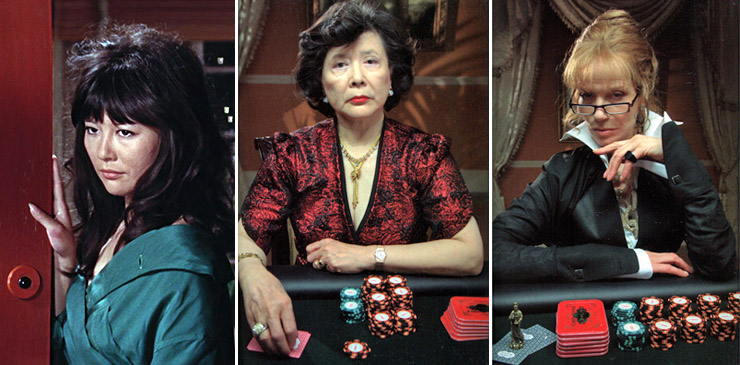 |
|||||||
|
EON Productions finally acquired the rights to Ian Fleming's first James Bond novel CASINO ROYALE in 1999 as part of a deal with Sony Pictures Entertainment, who exchanged them for Metro-Goldwyn-Mayer's rights to Spider-Man. After the success of Pierce Brosnan's third James Bond film The World Is Not Enough (1999) it was not felt that CASINO ROYALE would be an appropriate vehicle for the current 007, and Die Another Day went into production instead. With the exception of Judi Dench as M and the appearance of Bond's Aston Martin DB5 in Casino Royale (2006), the filmmakers kept any references to earlier films to a minimum, with the ‘James Bond Theme’ only heard at the end of the film. However, there were a few other connections to earlier films with cameo roles for Tsai Chin (1936- ) [who appeared with Sean Connery in the pre-credit sequence of You Only Live Twice (1967)], as Madame Wu (above centre) - who plays poker aboard Le Chiffre's yacht, and later at the casino table in Montenegro. Tsai Chin's brother Michael Chow also appeared in You Only Live Twice (1967) as SPECTRE #4. Diane Hartford who had appeared in Thunderball (1965) is one of the poker players at the ‘One And Only Club’ on Paradise Island in The Bahamas where James Bond (Daniel Craig) wins the Aston Martin from Alex Dimitrios (Simon Abkarian). Another of the poker players in Montenegro [pictured above right and listed in the end credits as Gräfin von Wallenstein] is German model, actress & artist Vera Lehndorff (1939- ), known professionally as Veruschka, and best-remembered for her brief five-minute appearance in the 1966 cult film Blow Up directed by Michelangelo Antonioni. |
|||||||
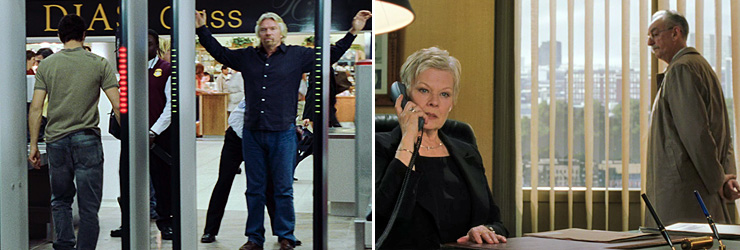 |
|||||||
|
When Bond (Daniel Craig) arrives at Miami International Airport, the entrepreneur and founder of the Virgin Group Sir Richard Branson (1950- ) is seen as a passenger being frisked by a security check-in guard as Carlos (Claudio Santamaria) enters the gate to his left. Virgin Atlantic planes appear on-screen in Casino Royale and Richard Branson (above left) was given the brief cameo in exchange for his assistance in providing an aircraft for the crew during production in Prague. Cinematographer Phil Méheux, who had earlier photographed GoldenEye (1995), also made a brief cameo appearance as ‘Treasury Bureaucrat’ (above right) in Casino Royale (2006). Bond tracks Alex Dimitrios to Miami, where he leaves a locker key (containing the device intended to destroy the Skyfleet prototype aircraft) for the terrorist Carlos on the table of a trio of poker players at the ‘Body Worlds Exhibition’ (below left). The interiors of the exhibition where James Bond and Alex Dimitrios face-off were actually filmed in Prague. The voice of German anatomist Gunther von Hagens (1945- ), who invented the technique for preserving biological tissue specimens called plastination, can be heard on the soundtrack. There were several variations of ‘Body Worlds’ across the globe, with the London exhibition coincidentally situated on Piccadilly Circus in the building that was formerly known as the London Pavilion (below right) - where Dr. No (1962) and Thunderball (1965) first screened during their premiere West End engagements. |
|||||||
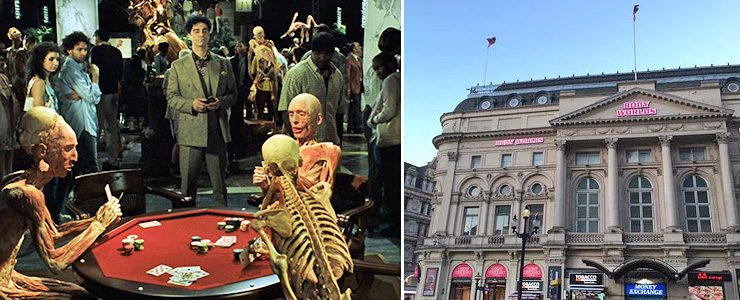 |
|||||||
|
|||||||
|
Although From Russia With Love (1963) could be considered a follow-up to Dr. No (1962) as reference to the title character is specifically made in the second James Bond film, the first true sequel is Quantum of Solace (2008), which begins exactly where Casino Royale (2006) ended. The other most obvious reference to an earlier film in the series, is the death of Agent Strawberry Fields (Gemma Arterton), whose demise is photographed to be an exact replica of the death of Jill Masterson (Shirley Eaton) in the classic Goldfinger (1964). The more permissive age allowed the fully nude body of Agent Fields to be shown covered in oil; whereas the gold painted body of Jill Masterson was protected by a strategically placed cushion in the frame. |
|||||||
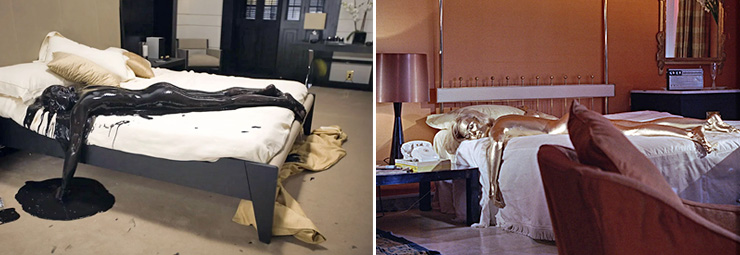 |
|||||||
|
Daniel Craig's second outing as James Bond features three scenes that are also direct homages to Roger Moore's third film as 007, The Spy Who Loved Me (1977). As Bond follows Camille (Olga Kurylenko) and tries to discover more about Dominic Greene's activities, he hands over his business card which bears the details ‘Universal Exports R. Sterling’ - a clear reference to Bond's pseudonym ‘Robert Sterling’ created by Christopher Wood for The Spy Who Loved Me (1977). The fictional company Universal Exports was created by author Ian Fleming as the cover-name for the secret service, first appearing in LIVE AND LET DIE (1954) and used throughout the film series since Dr. No (1962). Later in Quantum of Solace at the climax of the opera sequence, Bond despatches Guy Haines’ bodyguard by dropping him from a rooftop in an identical manner to that of Roger Moore's Bond, as Sandor (Milton Reid) falls to his death from an Egyptian rooftop. |
|||||||
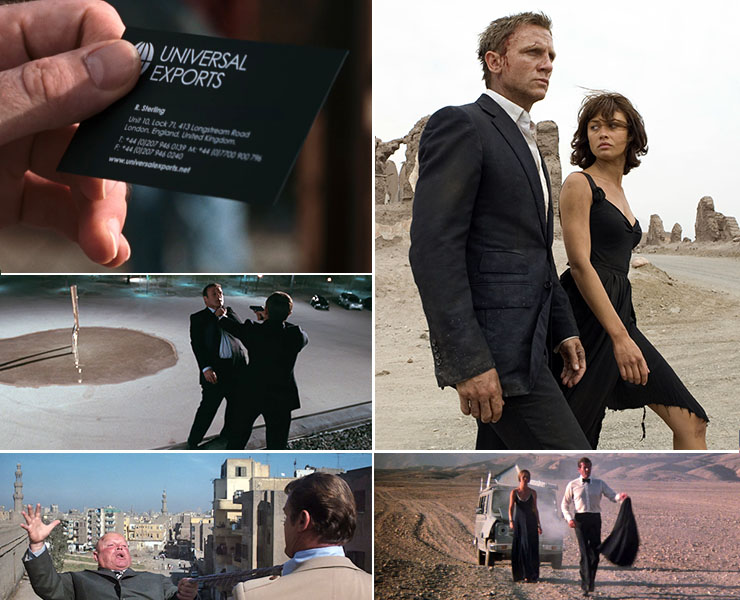 |
|||||||
|
|||||||
|
Early in Quantum of Solace James Bond (Daniel Craig) steals a photograph of Vesper Lynd (Eva Green) with Yusef Kabira (Simon Kassianides) - the man who betrayed her in Casino Royale. Vesper's Egyptian Love Knot necklace introduced in Casino Royale (2006) is retrieved by Bond from her former boyfriend and dropped in the Moscow snow at the end of the film, closing Vesper's story arc until it was resurrected in No Time To Die (2021). An identical necklace was given to the character of Corrine played by Canadian actress Stana Katic (below bottom right). The original necklace and earrings worn by Eva Green (below left) were commissioned for Casino Royale (2006) by English jeweller Sophie Harley. |
|||||||
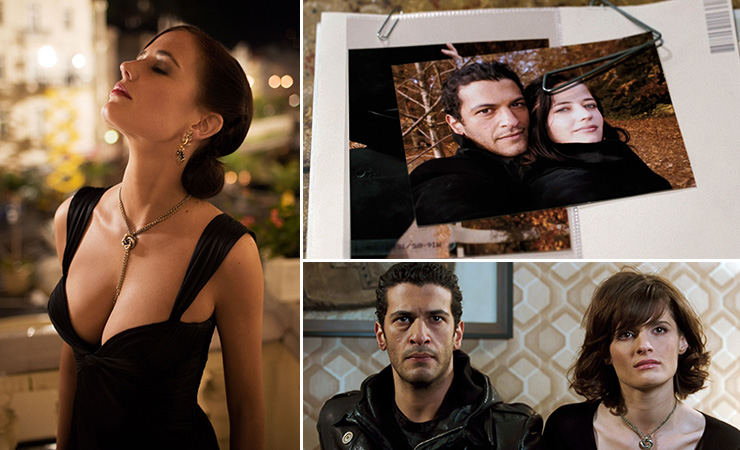 |
|||||||
|
Quantum of Solace features a very brief appearance by Spanish actress Oona Chaplin (1986- ) as the Perla de las Dunas receptionist, who is gagged and almost raped by the corrupt General Medrano (Joaquín Cosio). Her mother is American actress Geraldine Chaplin (1944- ). Oona [pictured below left] is also the grand-daughter of English film actor Charlie Chaplin (1889-1977), and great-granddaughter of American playwright Eugene O'Neill (1888-1953). Two additional voices heard in Quantum of Solace were those of notable Mexican film directors Alfonso Cuarón (1961- ), and Guillermo del Toro (1964- ) [pictured below right]. Cuarón can be heard as the Bolivian helicopter pilot chasing James Bond and Camille in the Douglas DC3; and del Toro was the voice of the guest congratulating Dominic Greene (Mathieu Amalric) at his ‘Greene Planet’ fundraising party in Bolivia, and heard speaking the line: “You know, there are people in this country spending half their paycheck just to get clean water”. |
|||||||
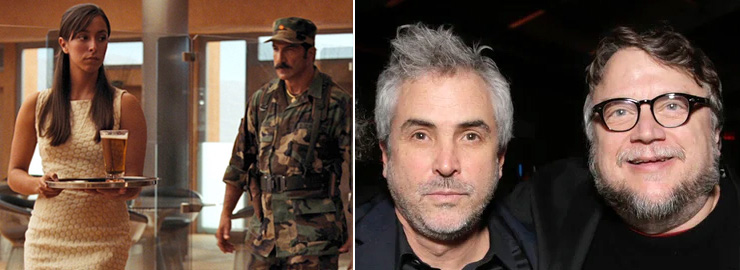 |
|||||||
|
|||||||
|
Daniel Craig's third film as James Bond re-introduced and re-invented the characters of Moneypenny (played by Naomie Harris) and Q (Ben Whishaw). Along with the re-introduction of Bond's beloved Aston Martin DB5, Skyfall (2012) had many nods to the past although staying with the new timeline established in Casino Royale (2006). Perhaps the most significant new development with the character of James Bond is the fleshing out of his background and reference to his parents Andrew Bond and Monique Delacroix. The identity of Bond's parentage was not disclosed by author Ian Fleming until his penultimate novel YOU ONLY LIVE TWICE (1964), when M writes the obituary of the secret agent, who is presumed dead at the end of the story. Ian Fleming reveals that both of Bond's parents were killed in a climbing accident in the Aiguilles Rouges above Chamonix when he was eleven years of age. In Skyfall (2012) their graves are now located in the churchyard of Skyfall Lodge - Bond's ancestral Scottish home. Screenwriters Neal Purvis & Robert Wade and John Logan now incorporate Bond as an orphan from the literary world into their retroactive continuity, and would further develop his backstory with a lesser degree of success in Spectre (2015). |
|||||||
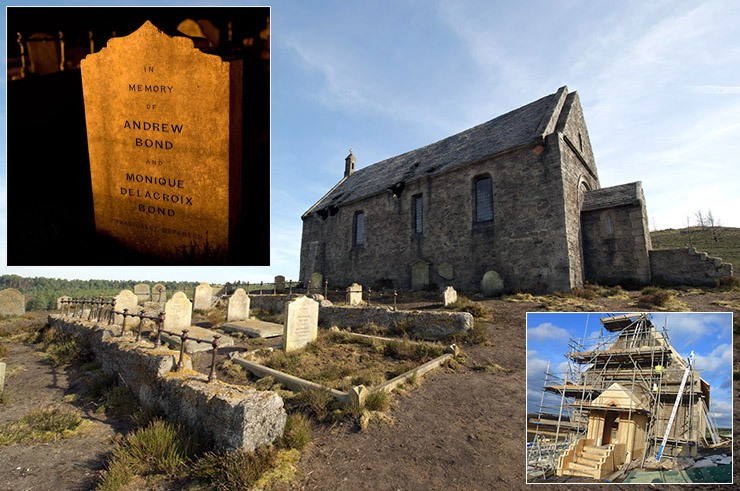 |
|||||||
|
The grave of Bond's parents can be seen in Skyfall (2012) as Silva (Javier Bardem) approaches the church on his way to confront M (Judi Dench), who is being protected by Kincade - the fictional gamekeeper of the Bond family estate, played (in his final film performance) by British character actor Albert Finney (1936-2019). A full-sized exterior set was constructed for Skyfall on Hankley Common in Surrey standing in for the Scottish Highlands. Also constructed for the set was a grave stone for Robert Bond (below top left), but was not ultimately seen on screen in the finished film. The inscription reads ‘IN MEMORY OF | ROBERT BOND | WHO DIED HERE | AT THE FALL OF GLENCOE’ - presumably a reference to the Glencoe massacre of February 16, 1692, where an estimated 30 members and associates of Clan MacDonald of Glencoe were killed by Scottish government forces, allegedly for failing to pledge allegiance to the new monarchs, William III and Mary II. Another broken headstone (below top right) is for the grave of Ramsay William Bond, his wife Margaret Jean Davison Bond, and their daughter. Also visible on the prop headstone (but not seen in the film) for Bond's parents (below bottom) beneath the line ‘Tragically departed’ is the Latin phrase ‘mors ultima linea rerum est’ which roughly translates as ‘death is the final limit of things’. |
|||||||
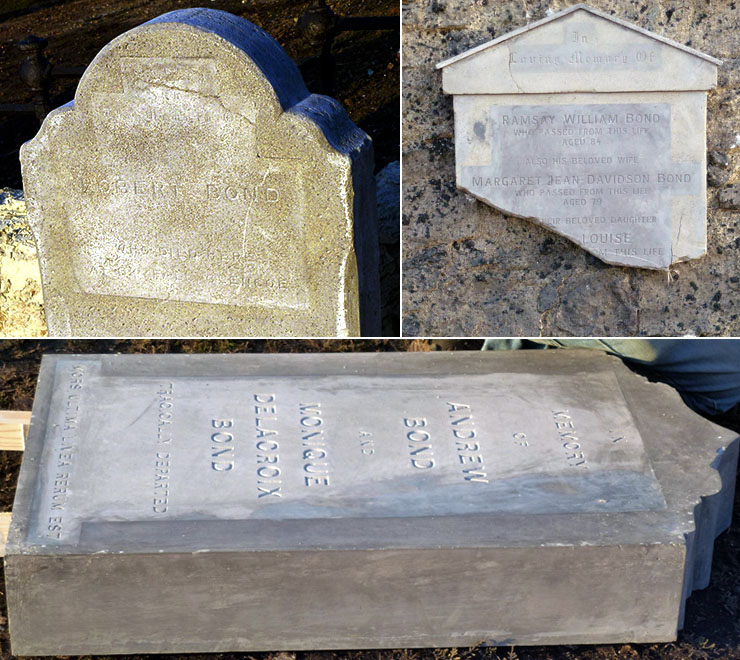 |
|||||||
|
|||||||
|
If Quantum of Solace (2008) was a direct sequel to Casino Royale (2006); starting exactly where its predecessor ended, Spectre (2015) can also be seen as a follow-up to Skyfall (2012) which itself was originally conceived as a standalone story. Daniel Craig's fourth 007 film contains several references to Skyfall, and also shares the same director Sam Mendes and co-screenwriter John Logan. However, the development of the storyline for BOND 24 underwent many changes, with Logan eventually departing the project, and British playwright Jez Butterworth brought in to polish the already confused script. During the early development of the story it was announced on November 15, 2013, that DANJAQ LLC and MGM had acquired the full copyright to the characters and concepts of Ernst Stavro Blofeld, and the organisation SPECTRE from the estate of Kevin McClory (1926-2006). The rights to the international crime syndicate had long been a thorn in the side of EON Productions, who had not been permitted to use any elements of SPECTRE, or its leader since Diamonds Are Forever (1971). Attempts to incorporate SPECTRE into the storyline of The Spy Who Loved Me (1977) were thwarted when McClory won a high court injunction against EON for alleged breach of copyright. At the time Kevin McClory, Sean Connery and author Len Deighton were in the pre-production/scripting stage of the film that would ultimately be released as Never Say Never Again (1983). McClory had licensed the rights he won in the 1963 court case against Ian Fleming to EON Productions for a period of ten years as they collaborated to make Thunderball (1965). After that time had elapsed McClory immediately began to exercise his rights, and attempted to make another James Bond film based on the original story he co-authored with Ian Fleming and screenwriter Jack Whittingham. The character of Blofeld (a bald-headed man in a wheelchair with a white cat) then appeared in the pre-credit sequence of For Your Eyes Only (1981), but never formally acknowledged as such in order to avoid further legal complications. His comic appearance undermines what was ultimately a more down-to-earth entry in Roger Moore's increasingly far-fetched tenure as James Bond. |
|||||||
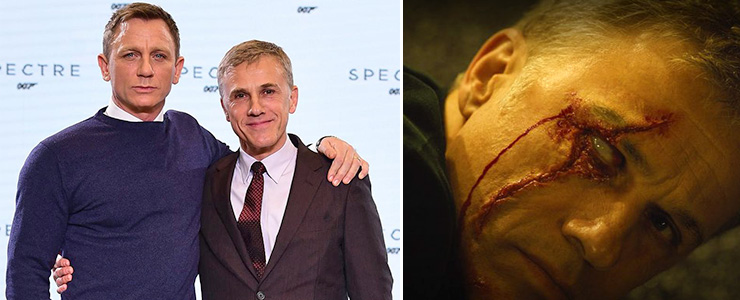 |
|||||||
|
On December 4, 2014 it was officially announced that the 24th James Bond film would be called Spectre. Just 10 days later EON Productions learned that an early version of the screenplay was amongst material stolen and illegally made public by hackers who infiltrated the Sony Pictures Entertainment computer system. At the launch of the new film at Pinewood Studios the cast were revealed and speculation began as to how SPECTRE would now be reintroduced to cinema audiences. At this stage the presence of Christoph Waltz in particular caused widespread rumour, with most observers suggesting the double Oscar-winning actor as a likely Blofeld, despite the announcement of his character’s name as Franz Oberhauser. Apparently the son of the original Ian Fleming character Hannes Oberhauser from the short story OCTOPUSSY, in which he was revealed to be the man who taught a young James Bond to ski and mountain climb. Hannes Oberhauser was killed in the short story by Major Dexter Smythe, who is also mentioned in the film Octopussy (1983) as being the father of the titular heroine played by Maud Adams. Ultimately, and not unsurprisingly, Christoph Waltz was revealed as Ernst Stavro Blofeld (and Bond's unlikely step-brother!) in Spectre, with the filmmakers going to extraordinary lengths to hide the fact as production got underway, and the media publicity machine went to work. It is interesting to note that the name Blofeld did not appear in the script until very shortly before production began. The Oberhauser character was masquerading as Heinrich Stockmann (Blofeld in all but name) and with a female sidekick called Irma. A day after the Pinewood launch it was also revealed by Jesper Christensen (in a key spoiler that doubtless infuriated EON) that the character of Mr. White would also feature in the new film – making it clear that Spectre would try to establish some form of link between its storyline and the ‘Quantum’ organisation which featured in Casino Royale and Quantum of Solace. Thus began the retroactive continuity which led to the revelation that the organisation ‘Quantum’ was indeed an offshoot of SPECTRE, and that Mr. White (now also the father of Madeleine Swann), Le Chiffre, Dominic Green and Raoul Silva were all SPECTRE operatives. The screenplay also integrated the back-story from Bond’s childhood (set up in Skyfall) and the introduction of SPECTRE, while also reconciling all these story beats with threads from the previous three Craig Bond films. The continuity was further developed and tied up in Daniel Craig's final appearance as James Bond No Time To Die (2021), which concluded his five film story arc. |
|||||||
 |
|||||||
|
Spectre (2015) includes some other nods to earlier James Bond novels, and other subtle ‘in-jokes’ that probably went unnoticed by the majority of audiences, as they tried to understand the overly complicated story. The main story itself begins with the uncredited cameo appearance of Judi Dench as M [pictured above left] on a recording delivered to Bond's London home. The scene in Bond's flat [seen on-screen for the first time since Live And Let Die (1973)], also includes the Union Jack bulldog bequeathed to Bond by his late boss at the end of Skyfall (2012). Another subtle on-screen reference was the acknowledgement of the recently deceased former associate/executive producer of six consecutive James Bond films from For Your Eyes Only (1981) to GoldenEye (1995). Thomas (Tom) Pevsner (1926-2014) was the son of distinguished architectural historian Sir Nikolaus Pevsner (1902-1983), and started his film career working at the National Film Finance Corporation, before becoming an assistant director on such notable films as The Ladykillers (1955), The Longest Day (1962), and The Private Life Of Sherlock Holmes (1970). In 1979 he was the associate producer of John Badham's stylish interpretation of Dracula starring Frank Langella before moving to the Bond series. In Spectre (2015) Daniel Craig's Bond meets his colleague Q (Ben Whishaw) at the Hoffler Klinik in the Austrian Alps, and asks “Where are you staying?”, to which Q replies “The Pevsner”. The mountaintop clinic can also be seen as a direct reference to Blofeld's Swiss retreat in On Her Majesty's Secret Service (1969), originally created by Ian Fleming in his 1963 novel, and another piece of plot misdirection. An earlier nod to the Executive Producer can also be seen on one of the computer screens in the Arecibo Complex at the end of GoldenEye (1995) which displays “Pevsner Commerzbank GmBH”. |
|||||||
|
|||||||
|
At the climax of Spectre (2015) M (Ralph Fiennes) arranges to meet Bond at a safe house in London. The house has a door plate bearing the words ‘HILDEBRAND PRINTS & RARITIES’ as a nod to Ian Fleming's 1959 short story THE HILDEBRAND RARITY. Earlier in the film Bond is tortured by Blofeld at his Moroccan hideout by being strapped to a chair, whilst various surgical instruments penetrate his skull with the intent to cause a loss of memory and identity. The genesis of the scene (and much of the actual dialogue spoken by Christoph Waltz) is taken directly from the 1968 James Bond novel COLONEL SUN by Kingsley Amis (writing as Robert Markham). The inclusion of the torture sequence from COLONEL SUN was also a last-minute addition to the script. Earlier drafts had Bond beaten up by Stockmann, who was also holding Q as a hostage. Although the estate of Kingsley Amis is thanked in the end credits of Spectre, it is doubtful that the majority of audience members apart from die-hard literary 007 fans, would have made the connection with the first James Bond continuation novel written following the death of author Ian Fleming in 1964. A toned-down version of the torture scene was illustrated by Yaroslav Horak for the 1969/70 Daily Express comic strip adaptation of COLONEL SUN. Other elements from COLONEL SUN have been used in The World Is Not Enough (1999) and Die Another Day (2002). Although the film rights to COLONEL SUN have been held by EON Productions since its publication, it is a mystery why it was never considered as a film in its own right. |
|||||||
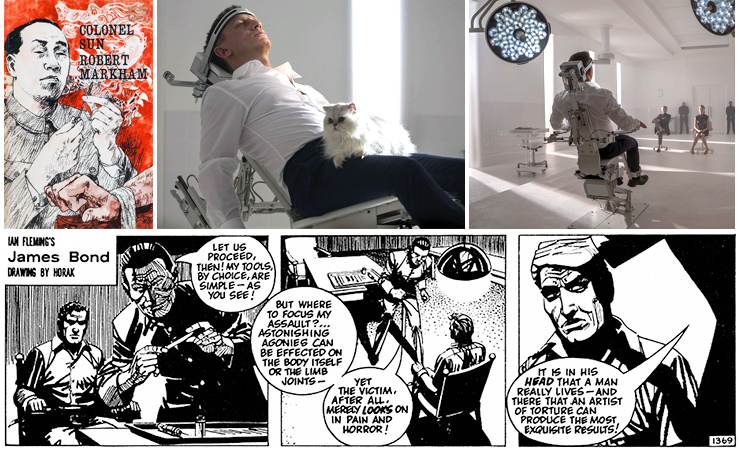 |
|||||||
|
|||||||
|
The main titles of No Time To Die (2021) designed by Daniel Kleinman are littered with references to motifs from earlier title sequences, and serve to link the film with the 24 previous adventures in the series. In Casino Royale (2006) Daniel Craig was established as a different James Bond to the one played by Sean Connery, George Lazenby, Roger Moore, Timothy Dalton and Pierce Brosnan. Craig's five films can be seen as a separate standalone story arc, but from the start there were still many references to the earlier films in the series using recognisable touchstones such as the Aston Martin DB5, which also appears in No Time To Die (2021) but now with the same gadgets featured on the original version seen in Goldfinger (1964). The bullet-ridden version from the pre-credit sequence also appears in Daniel Kleinman's titles. |
|||||||
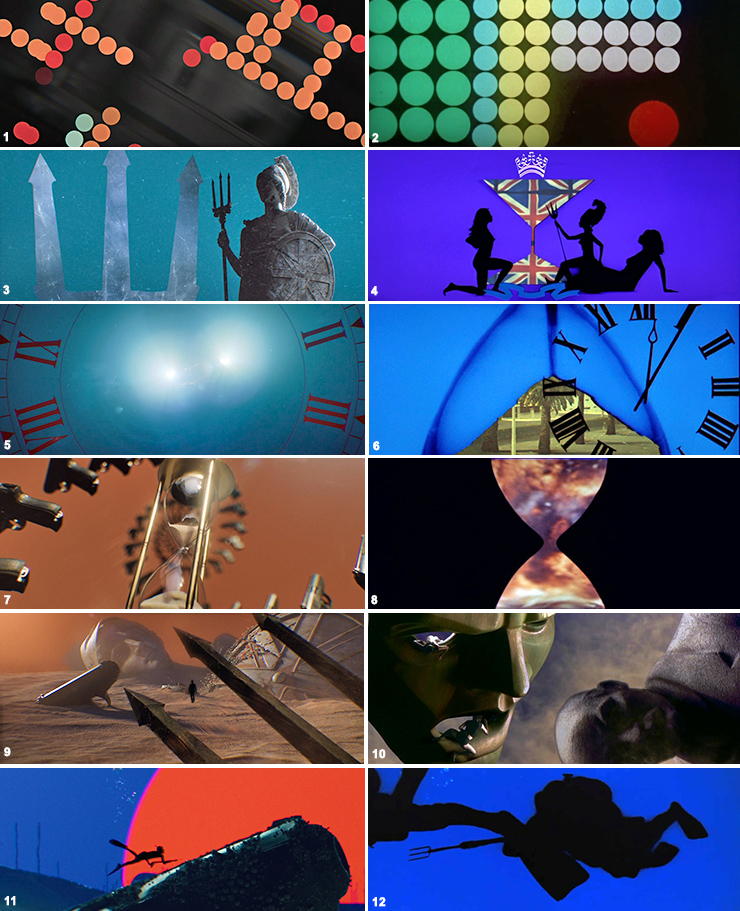 |
|||||||
|
(1) The No Time To Die main titles open with the same coloured dots seen in Dr. No (2). The sequence then introduces the figure of Britannia - the personification of Britain as a helmeted female warrior holding a trident and shield (3) first seen in On Her Majesty's Secret Service (4). The clock face (5) and hourglass (7) motifs in No Time To Die are also taken from On Her Majesty's Secret Service (6) & (8); whilst the fallen statue of Britannia being sucked into the sand of an hourglass to signify that time is running out (9), is a direct reference to GoldenEye (10), where the fallen bust of Lenin symbolised the collapse of the Soviet Union and end of the Cold War. Finally at the end of the No Time To Die titles a tiny diver (11) is seen swimming through the frame in a direct nod to Maurice Binder's silhouetted underwater figures from the Thunderball (12) main titles. Other motifs such as Bond's Walther PPK, and the faces of characters from other Daniel Craig Bond films can also be seen in the main titles for No Time To Die. Just as Maurice Binder had used clips from earlier films in the titles for On Her Majesty's Secret Service (1969) to connect the latest story to what had gone before, Daniel Kleinman uses the same concept in No Time To Die (2021) - which can almost be viewed as a James Bond greatest hits package! |
|||||||
|
|||||||
|
The introduction of Daniel Craig as James Bond in Casino Royale, and his Double-O status confirmed in the main title sequence following the killing of Dryden (Malcolm Sinclair), was a clear indication that this was not the same character seen in the film series from 1962 to 2002. Although Judi Dench continued as M, her timeline must therefore also be changed as she becomes the boss to a new alternate version of 007. The only other link to the earlier films was the appearance of a left-hand drive version of Bond's Aston Martin DB5, which he wins in a poker game in The Bahamas. This same car (but now a right-hand drive version!) is later equipped with several special features by ‘Q Branch’, including the twin Browning Machine Guns behind the indicator lights as seen in Goldfinger (1964) and Skyfall (2012). The DB5 Bond drives in Skyfall (2012) also has the same number plate BMT 216A as seen on the car in Goldfinger (1964) and Thunderball (1965). After Silva's men destroy Bond's Aston Martin DB5 it is rebuilt by Q and appears in the final shot of Spectre (2015) as 007 drives off with Madeleine Swann (Lea Seydoux). It is presumably the same car that Bond then drives in Matera during the pre-credit sequence of No Time To Die (2021), where we now see the ejector seat roof panel above the passenger seat (also referenced by M in Skyfall). Bond utilises the smoke screen (first seen on the DB5 in Goldfinger) and escaping from Primo's (Dali Benssalah) men by deploying the twin Gatling Machine Guns now hidden behind the front headlamps. |
|||||||
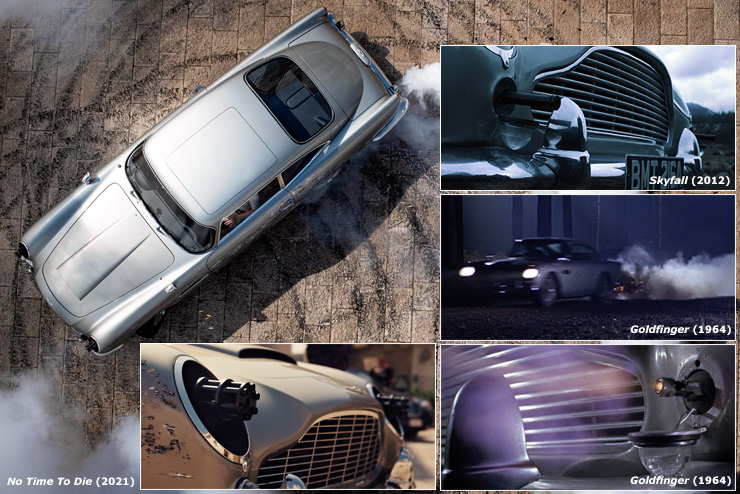 |
|||||||
|
Although Pierce Brosnan's James Bond drives an Aston Martin DB5 in GoldenEye (1995) and Tomorrow Never Dies (1997) the number plate seen on the car is BMT 214A. A DB5 with the same registration was present on set [pictured below] for Sir Robert King's (David Calder) funeral scene filmed at Stowe School, Buckinghamshire at the start of The World Is Not Enough (1999), but the sequence was ultimately not used in the finished film. |
|||||||
 |
|||||||
|
As the 25th entry in the long-running series No Time To Die has many other nods to earlier James Bond films, including the ‘Hazmat’ suits worn by Dr. Hardy (Hugh Dennis) and Valdo Obruchev (David Dencik), which are very similar to those featured in Dr. No (1962). Safin's (Rami Malek) technicians also wear pink and green safety suits matching the colours of those seen in the first James Bond film. |
|||||||
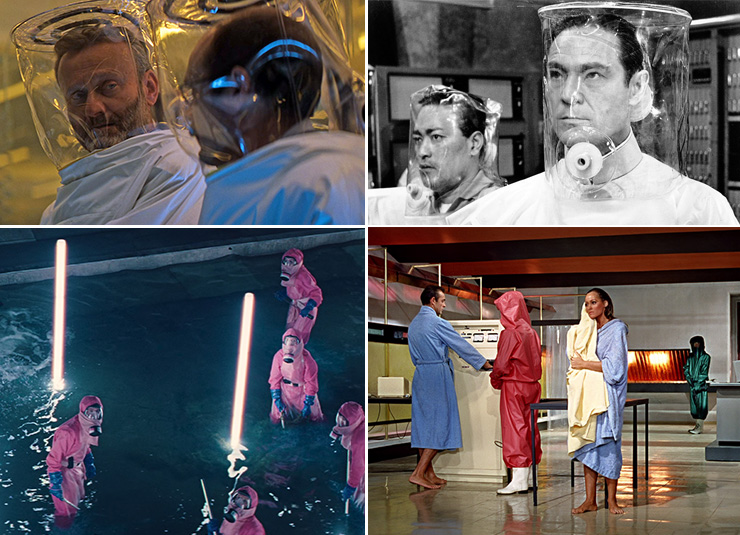 |
|||||||
|
The very first car driven by James Bond (Sean Connery) in Dr. No (1962) was a Chevrolet Bel Air (below top left), and an identical coloured model appears at the conclusion of the Havana sequence as the vehicle Paloma (Ana de Armas) crashes into scaffolding at the end of her memorable appearance in No Time To Die (2021). Other visual homages include the inflatable dinghy in which Bond (Sean Connery) and Kissy (Mie Hama) escape Blofeld's erupting volcano hideout in You Only Live Twice (1967), which is very similar to the one Bond (Daniel Craig) is seen in before he is rescued in No Time To Die (2021). |
|||||||
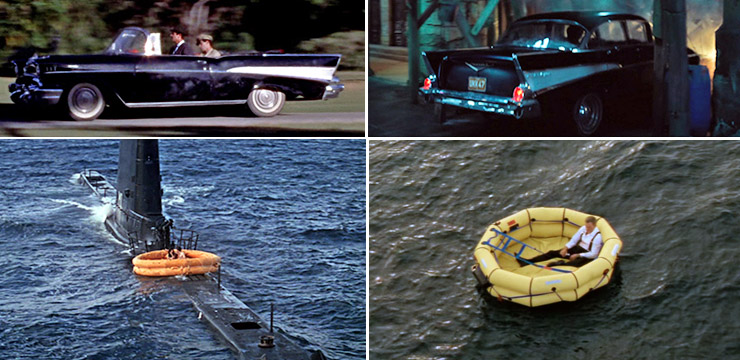 |
|||||||
|
For Your Eyes Only is also referenced in No Time To Die (2021) as Bond kills Logan Ash (Billy Magnussen), in the same way Roger Moore's Bond had despatched Locque (Michael Gothard) in the 1981 film. At the start of No Time To Die Bond visits the grave of his former lover Vesper Lynd, in a scene that echoes Roger Moore's 007 placing flowers on the grave of his murdered wife Tracy in the pre-credit sequence of For Your Eyes Only (1981). But perhaps the biggest influence on the 25th James Bond film was On Her Majesty's Secret Service (1969). The most obvious reference is the use of the line “We Have All The Time In The World”, and appearance of Louis Armstrong's song over the closing credits. Composer Hans Zimmer also interpolated John Barry's orchestral version of ‘We Have All The Time In The World’ into the track ‘Matera’, and the main theme from On Her Majesty's Secret Service was re-orchestrated as ‘Good To Have You Back’ as Bond and M (Ralph Fiennes) meet on London's Thames embankment. |
|||||||
|
|||||||
|
In No Time To Die Bond is now living in a bungalow on the island of Jamaica, which is clearly modelled on ‘Goldeneye’ - the home of James Bond author Ian Fleming. Literary references from Ian Fleming's penultimate James Bond novel YOU ONLY LIVE TWICE are also included in No Time To Die. In both the novel and film Bond utters the words “Die. Blofeld. Die.” as he kills his nemesis, but its appearance in No Time To Die comes across as somewhat forced. Safin's poison garden is a direct reference to the ‘Garden of Death’ where Japanese people flock to commit suicide in YOU ONLY LIVE TWICE, and operated by Blofeld under the guise of Doctor Shatterhand. The words spoken by M (Ralph Fiennes) as part of the cinematic James Bond's eulogy are also taken from YOU ONLY LIVE TWICE. It is the character of Mary Goodnight in the novel who suggested the phrase “I shall not waste my days in trying to prolong them. I shall use my time.” as a suitable epitaph for the secret agent who, at the end of the novel, is missing presumed dead. The quote is originally attributed to American novelist Jack London (1876-1916). In No Time To Die M reads the full quote as Bond's eulogy: “The proper function of man is to live, not to exist. I shall not waste my days in trying to prolong them. I shall use my time”. The demise of the lead character in No Time To Die (in the story arc created in the five Daniel Craig films at least) appears to be final, although the end credits of the film assure audiences it is not. |
|||||||
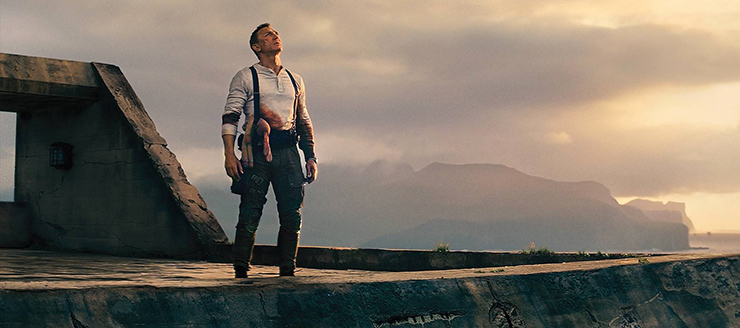 |
|||||||
|
|||||||
|
|
FACT FILES - UK Posters |
|
|||||